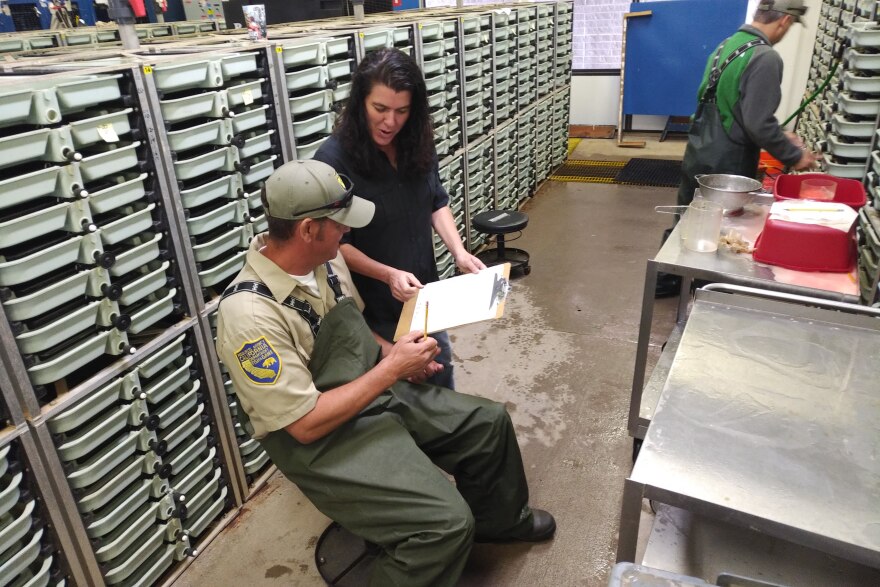The Coleman National Fish Hatchery is where the timeless majesty of nature collides with industrial efficiency. Rather than a remote high country stream or a bear’s mouth, the lives of thousands of salmon following an epic migration end in this small warehouse-like building. Fighting through the last barrier, these burly kings or Chinook salmon flop into a tub, splashing and writhing until carbon dioxide pumped into the tank sort of stuns them.
A constant stream of river water flows into various tanks and onto the floor adding to the cacophony. Yanked out one by one, technicians instantly determine the fish’s sex and if they’re at their prime for human-aided spawning. It’s barely past 11 a.m. and the important work of the day is done.
Workers have already gathered all the eggs they’ll need. The rest of the fish are sorted. The so-called unripe are flopped back into a large cement holding tank, the others: killed, packed on ice, processed offsite and distributed to native tribes and food pantries.

Meanwhile, Chinooks, averaging about 35 lbs a piece, are scrambling up the fish ladder by the barrelful.
After dwindling in recent years, Bret Galyean the project leader at Coleman National Fish Hatchery in Anderson said California’s salmon appear to be making a comeback.
“We’re just now starting to hopefully get some better returns, even though the drought’s been over for several years," he said.

Galyean said that over the last ten days he and his team have already seen the same number of fish they saw last year in a span of six weeks.
"So it looks good, I’m very optimistic," he said. "Preliminary estimates are about 20,000 fish should be returning, just to Battle Creek, so, I’m very optimistic that the hatchery can get back to fulfilling its mitigation goal of producing 12 million smolts in 2019."
A smolt being a young silver-colored salmon that's old enough to migrate to the ocean for the first time.
Before California’s rivers were dammed, salmon, especially spring-run fish, would migrate into the high country, spawning in cold mountain streams. With most of their habitat now inaccessible, the hatcheries aim to replace the lost numbers.
The rebound Galyean is anticipating is already well documented at theFeather River Fish Hatchery in Oroville. It’s also evident on Butte, Deer and Mill creeks, which are the few Sacramento River tributaries still home to wild salmon. Further north and west, fish counts on the Trinity River, where habitat restoration continues, are the highest since at least 2004.
Virtually all of the fish returning to Oroville are three years old according to tags read by hatchery employees. Typically three-year-olds make up four out of every five. That other 20 percent is part of the salmon’s secret of survival. More on that below.
Tracy McReynolds is a Senior Environmental Scientist with the California Department of Fish and Wildlife.
“Survival seems to be pretty well from the 2015 class," she said. "Most of the fish that are returning are three year old fish, so that would have meant they went out in 2015. Out in the ocean and returning."
In 2015, California was in the midst of a multi-year drought. By February 2016 there was talk of reservoirs becoming dead pools. Then, it started raining. And raining. And raining. Anna Kastner is the manager of the Feather River Fish Hatchery.
“We had that really incredible March, that got us a whole bunch of water, and that’s exactly about the same time that we’re putting the fish into the river to migrate out, so, that march really helped push those fish out, compared to the 2014 year when we had drought, drought, drought, really high temperatures in the river and a lot of the fish didn’t come back," she said. "That little bit of rain in March was a miracle, it really pushed those fish out, and this is the result of it."
The trend seems true across the watershed. McReynolds said spring-run counts on Butte Creek, after cratering below 1,000 fish last year, are up by a factor of four.
Though right about average for recent years, that number is barely 20 percent of 1998’s record run.

Salmon’s Secret Of Survival
So, what about the non-three year old fish? McReynolds explained that scientists liken them to insurance for the species. While not well understood, some salmon return after only two years in the ocean. Others wait four or even five years. By staggering their returns, salmon can outmaneuver droughts or other short lived cataclysms.
“They kind of are naturally built to weather these kind of periods of drought. Populations oscillate up and down and hopefully we’re back on an upswing," McReynolds said. "This year it looks very promising and then we have brood year next year we’re hoping will be really successful because it would be off of 2016 which was a really wet year.”
You can see the evidence yourself. Kastner said the number of salmon returning to Oroville will peak in the last half of the month. The Coleman National Fish Hatchery has a whole series of public events as part of their Return of the Salmon Festivalon Oct. 20th.





